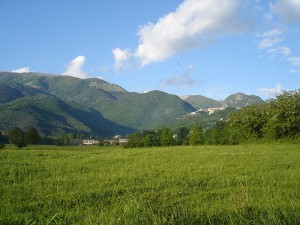By Paul Bray
For 6 months in 1996-97 I had the opportunity of living at the American Academy in Rome as a recipient of a Rome Prize.
As an advocate of parks, protected areas and historic preservation in New York State and beyond, my interest has been less with the traditional public estate parks (local, state and national) and more with area wide parks, greenways, landscapes and heritage areas like the six million acre Adirondack Park, the 3 million acre Hudson River Greenway and state and national heritage areas.
I expected to find historic landscapes in Italy that were being managed as parks, but thanks to the emerging effect of the European Union (“EU”) I found more park interest and activity than I expected. The EU set a standard for each EU nation to have at least 10% of its land mass be managed as park or protected area. At the time this standard was established Italy had only 4 National Parks and 1% of its land mass protected. By 2000 Italy could claim it met the 10% standard and it had more than 20 national parks complemented by regional parks like Alpi Apuana, a mountain top region of northern Tuscany with the marble mines that provided the marble used by Michelangelo.
My interaction with Italian park and conservationists was interesting and enriching. As an American, I was welcomed as a national of a nation with the global Mecca of parks, Yellowstone National Park.
Yet, as I got to know the Italians and told them about the Adirondack Park and our heritage areas, we had a new and unexpected common ground. I was not the “know it all American” but someone who admired and wanted to learn about Italian parks like the Italian Abruzzo National Park, the Po Delta Park and the Pisa Regional Parks.

The Abruzzo Park about 2 hours from Rome and Naples in the Apennines was a small 100,000 acre model of the Adirondack Park, but it was also awesome in its beautiful surround of 6,000 foot mountains, its medieval villages strung along its basin and its remarkable wild life including a sustainable population of 50 wolves. The wild life was nurtured at the same time eco-development was fostered in the Park’s villages through, for example, visitor centers in each village and stores selling products of the park. This was happening as mountain villages in other parts of Italy were dying.
To make a long story short, ties were established between parks and protected areas in New York State and Italy. A conference with Italians from all parts of Italy was held in Rome at the American Academy and a couple of the Italians suggested “twinning” Italian and American parks like sister cities. A description of some of the twinning activity can be found at the following: http://www.braypapers.com/IAPT.html
As a result of the Great Recession in 2008 and some changes in leadership in some of the parks, the formal exchanges have declined. Now the only formal, ongoing twinning is between the Central Pine Barrens on Long Island and the Pisa Regional Parks. Thanks to the assistance from the Brookhaven Lab and the links for ongoing, real time through camcorders biodiversity projects that were established between schools on Long Island and Pisa, the Pisa-LI twinning continues. Informally, contacts continue between people that where involved in the other formal twinnings. Contacts between planners and academics in Italy and the USA led to the recent publication of Parks and Territories: New Perspectives and Strategies edited by Francesco Morandi, Federico Niccolini and Massimo Sargolini. Retired Professor Roberto Gambino is coordinating another book of articles on park and landscape planning.
The Italian-NYS park twinning fits very well with the observation of Canadian’s J.Gordon Nelson and Lucy M. Sportza in their article ‘The Evolving Shift in Protected Area Thought and Practice”:
We are living in a shifting and evolving framework for protected areas, nature conservation and sustainable development. This situation is marked by the involvement of many government agencies and private groups not only in the lands and waters in and around protected areas, but those that are far away. In these circumstances concerned agencies and private groups cannot easily regulate or direct on another’s activities. Civic arrangements need to be encouraged so that the array of stakeholders concerned about protected areas, nature conservation and sustainable development can learn mutually for one another and find ways to communicate, negotiate, plan and act in the individual and the common interest. In this respect pluralism needs to be explicitly recognized and to be dealt with in a collaborative rather than a predominantly or exclusively corporate manner. The human dimension of protected area planning, management and decision making requires as much attention as science at the local, provincial or state, national and international scales of thought and practice.
The human dimension of the park twinning which included park officials, managers, advocates and various stakeholders allowed many to “learn mutually from one another and find ways to communicate, negotiate, plan and act in the individual and common interest”. Mutual learning complemented by ongoing communication continues.


